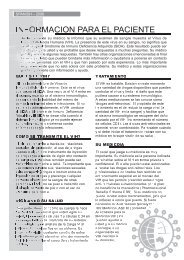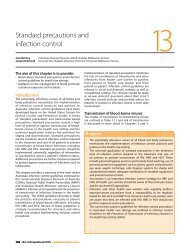HIV, HBV, HCV and STIs: similarities and differences - ASHM
HIV, HBV, HCV and STIs: similarities and differences - ASHM
HIV, HBV, HCV and STIs: similarities and differences - ASHM
Create successful ePaper yourself
Turn your PDF publications into a flip-book with our unique Google optimized e-Paper software.
1 <strong>HIV</strong>, <strong>HBV</strong>, <strong>HCV</strong> <strong>and</strong> <strong>STIs</strong>: <strong>similarities</strong> <strong>and</strong> <strong>differences</strong><br />
occurs in approximately 5% of deliveries, although<br />
this may be higher in women who have <strong>HIV</strong> coinfection<br />
or high levels of viraemia. Elective caesarean<br />
section in women with <strong>HIV</strong>/<strong>HCV</strong> co-infection is usually<br />
advocated, although its role in reducing perinatal<br />
transmission in women with <strong>HCV</strong> mono-infection is<br />
unclear <strong>and</strong> is generally not recommended as routine<br />
in this context. 21<br />
Chlamydia trachomatis<br />
Chlamydia trachomatis tends to infect columnar<br />
epithelium rather than squamous epithelium. Direct<br />
mucous membrane-to-mucous membrane contact<br />
facilitates transmission <strong>and</strong> chlamydial elementary<br />
bodies in infected genital secretions <strong>and</strong> discharges<br />
readily seed uninfected mucous membrane <strong>and</strong> cause<br />
infection in columnar cells. During birth, transmission<br />
occurs from a mother with cervical chlamydial<br />
infection to the child very efficiently (overall risk is<br />
50–75%).<br />
Indirect transmission of chlamydial infection by<br />
fomites appears to be extremely uncommon.<br />
Lymphogranuloma venereum (LGV) serovars are<br />
transmitted similarly by direct surface to surface<br />
contact or contamination of susceptible genital<br />
surfaces by contaminated secretions. The recent<br />
LGV outbreak in men who have sex with men (MSM)<br />
appears to be predominantly via anal intercourse with<br />
multiple partners, fisting <strong>and</strong> use of contaminated<br />
sex toys. For all practical purposes, transmission of<br />
the genital serovars of C. trachomatis is sexual <strong>and</strong><br />
vertical only, <strong>and</strong> conjunctival infection in the adult<br />
results from auto-inoculation with infected secretions<br />
from genitals to eye by the patient’s own fingers. 22<br />
HSV-1 <strong>and</strong> HSV-2<br />
Sexual transmission is a highly significant method<br />
of transmission of these viruses. 23 However, most<br />
people with oral <strong>and</strong> labial cold sores are infected<br />
with HSV-1 in childhood usually by being kissed on<br />
or near the mouth by family or relatives. Once they<br />
grow up <strong>and</strong> become sexually active, they can pass<br />
HSV-1 on to various anatomical sites in one or other<br />
of their sexual partners by kissing or by oro-vulval,<br />
oro-penile or oro-anal sex. A significant proportion of<br />
anogenital herpes is due to HSV-1 infection (30% or<br />
more in many studies). 25<br />
All that is required for transmission of HSV-1 or HSV-<br />
2 is for the virus from an infected person to come<br />
in contact with a mucosal surface (vaginal, cervical,<br />
rectal, pharyngeal, buccal, labial, conjunctival) or a<br />
slightly abraded skin surface anywhere on the body<br />
of a susceptible person.<br />
People never exposed to either virus are most<br />
susceptible <strong>and</strong> may develop a severe primary<br />
attack when infected; those with antibodies to one<br />
or other HSV, demonstrating previous exposure,<br />
are still capable of being infected by the alternative<br />
virus but have some degree of protection <strong>and</strong> may<br />
16 <strong>HIV</strong>, viral hepatitis <strong>and</strong> <strong>STIs</strong>: a guide for primary care<br />
suffer a less severe infection. The two viruses exhibit<br />
different tropism for anatomic sites; HSV-1 can<br />
infect both oral <strong>and</strong> genital sites but tends to thrive<br />
better in the mouth area, in that it reactivates more<br />
commonly there with viral shedding <strong>and</strong> sometimes<br />
with clinically obvious recurrences; HSV-2 can also<br />
infect both oral <strong>and</strong> genital sites but thrives better in<br />
the genital region.<br />
However, surprisingly, a study published in 2006 of<br />
men seropositive for HSV-2 (about half of whom were<br />
also <strong>HIV</strong> positive), showed that 40% of the men shed<br />
HSV-2 from both genital <strong>and</strong> oral sites. Oral shedding<br />
was always asymptomatic, it usually occurred at the<br />
same time as genital shedding <strong>and</strong> it occurred more<br />
commonly in <strong>HIV</strong>-positive men. 26<br />
All these facts explain why HSV infection is so<br />
common in sexually active people <strong>and</strong> why control of<br />
the spread of infection in communities presents such<br />
a challenge. Transmission rates can be reduced with<br />
careful <strong>and</strong> consistent condom use, <strong>and</strong> suppressive<br />
therapy with antiviral drugs for those who suffer<br />
frequent recurrences. Only an effective vaccine will<br />
make a significant impact on the problem of herpes<br />
simplex virus infection at population level.<br />
All forms of sexual contact can lead to transmission of<br />
HSV-1 or HSV-2 <strong>and</strong> mother-to-child transmission can<br />
occur at the time of birth. Neonatally acquired herpes<br />
can be a devastating <strong>and</strong> life-threatening disease.<br />
Fortunately mothers who are already infected with<br />
herpes provide their own antibodies transplacentally<br />
which substantially protect the infant from infection,<br />
even if HSV is shed by the mother around the time of<br />
delivery. However, if a pregnant woman is infected in<br />
the anogenital region with HSV-1 or HSV-2 in the last<br />
trimester of pregnancy <strong>and</strong> fails to develop significant<br />
HSV antibody levels (as shown by testing prior to<br />
delivery), the baby is at significant risk of acquiring<br />
neonatal herpes. In this situation obstetricians<br />
recommend a caesarean section birth. 4<br />
Human papillomavirus<br />
Sexual contact of all types accounts for all genital<br />
HPV infection. This includes the low-risk HPV types<br />
which result in the growth of genital warts <strong>and</strong> the<br />
high-risk HPV types that are associated with anogenital<br />
cancers. Genital HPV is a sexually transmitted<br />
infection demonstrated by the now well established<br />
fact that women without a present or prior sex<br />
partner tend to have a very low yield of HPV DNA in<br />
cervico-vaginal secretions, women with only one sex<br />
partner have a slightly higher yield <strong>and</strong> women with a<br />
history of more than one partner have a substantially<br />
higher yield.<br />
Each time a person acquires a new sex partner, that<br />
person's risk of acquiring genital HPV increases<br />
considerably. The consequence is that most sexually<br />
active adults have acquired one or more of the<br />
plethora of genital HPV types by the time they<br />
reach their fourth decade. Direct skin-to-skin, skin






